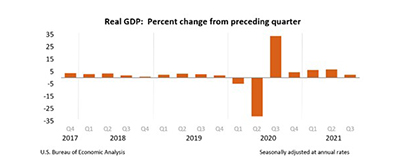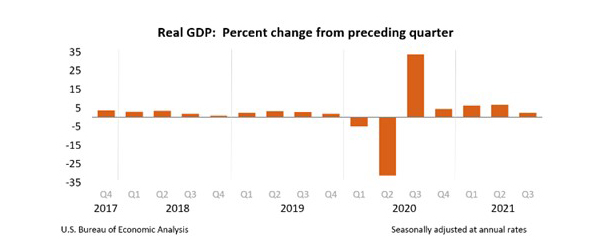
3Q GDP Settles in at 2.3%

U.S. Gross Domestic Product increased by 2.3 percent annually in the third quarter, a somewhat slower pace than the second quarter amid new COVID concerns, according to the third (final) estimate by the Bureau of Economic Analysis.
The final estimate of GDP was based on more complete source data than were available for the “second” estimate issued last month. The update primarily reflects upward revisions to personal consumption expenditures (PCE) and private inventory investment that were partly offset by a downward revision to exports. Imports, which are a subtraction in the calculation of GDP, were revised down.
In the second estimate, the increase in real GDP was 2.1 percent. In the second quarter, real GDP increased by 6.7 percent.

BEA noted a resurgence of COVID-19 cases resulted in new restrictions and delays in the reopening of establishments in some parts of the country. Government assistance payments in the form of forgivable loans to businesses, grants to state and local governments, and social benefits to households all decreased. The increase in real GDP in the third quarter reflected increases in private inventory investment, PCE, state and local government spending and nonresidential fixed investment, partly offset by decreases in exports, residential fixed investment and federal government spending. Imports increased.
The increase in private inventory investment reflected increases in wholesale trade (led by nondurable goods industries) and in retail trade (led by motor vehicles and parts dealers). The increase in PCE reflected an increase in services, partly offset by a decrease in goods. Within services, increases were widespread with the largest contributions coming from “other” services (mainly international travel) and transportation services. The decrease in goods primarily reflected a decrease in spending on motor vehicles and parts. The increase in state and local government spending was led by employee compensation (notably, education). The increase in nonresidential fixed investment reflected an increase in intellectual property products (led by software and research and development) that was partly offset by decreases in equipment and structures.
The decrease in residential fixed investment primarily reflected decreases in improvements and in new single-family structures. The decrease in federal government spending primarily reflected a decrease in nondefense spending on intermediate goods and services after the processing and administration of Paycheck Protection Program loan applications by banks on behalf of the federal government ended in the second quarter. The decrease in exports reflected decreases in both goods and services. The increase in imports primarily reflected an increase in services (led by travel and transport).
The report said current dollar GDP increased by 8.4 percent at an annual rate, or $461.3 billion, in the third quarter to $23.20 trillion. In the second quarter, GDP increased 13.4 percent, or $702.8 billion.
Additionally, the report said real gross domestic income increased by 5.8 percent in the third quarter, compared to 4.3 percent in the second quarter. The average of real GDP and real GDI, a supplemental measure of U.S. economic activity that equally weights GDP and GDI, increased 4.1 percent in the third quarter, compared with an increase of 5.5 percent in the second quarter.
